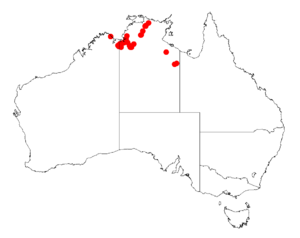Acacia jasperensis facts for kids
Quick facts for kids Acacia jasperensis |
|
|---|---|
| Conservation status | |
| Scientific classification | |
| Genus: |
Acacia
|
| Species: |
jasperensis
|
 |
|
| Occurrence data from AVH | |
Acacia jasperensis is a type of shrub or small tree. It belongs to the Acacia plant family. This plant is special because it is found only in the northwestern part of Australia. This means it is endemic to that area.
About the Acacia Jasperensis Plant
This tall, thin shrub or tree can grow up to 6 metres (19.7 ft) high. It has bright yellow flowers. The plant has thick, green, leaf-like parts called phyllodes that stay green all year.
After the flowers bloom, long, flat seed pods grow. These pods are narrow and rounded over the seeds in the middle. They can be up to 10 cm (3.9 in) long and 8 to 18 mm (0.31 to 0.71 in) wide. The pods are thin like paper (this is called chartaceous) and have a white, powdery coating. Inside the pods, the seeds are shiny and round or oval-shaped. They are about 3 to 4.5 mm (0.12 to 0.18 in) wide.
How it Was Named
A botanist named J.R. Maconochie first officially described Acacia jasperensis in 1982. He wrote about it in a paper called A new species of Acacia from the Northern Territory. This paper was published in the Journal of the Adelaide Botanic Gardens.
Later, in 2003, another botanist named Leslie Pedley changed its name to Racosperma jasperense. But then, in 2006, it was moved back to the Acacia group.
Acacia jasperensis is part of a group of plants called the Acacia juncifolia group. It is also closely related to another plant called Acacia alleniana. The first plant specimen used to describe the species was collected by Maconochie in 1981 at Jasper Gorge, which is in Keep River National Park.
Where it Grows
This plant naturally grows in the Northern Territory and the Kimberley region of Western Australia. You can find it growing among sandstone rocks and on sandstone hills.
The western edge of where this plant grows is east of Kununurra. From there, it is found in different spots across the top end of the Northern Territory. This includes places like Keep River National Park and near Mount Brockman in the Kakadu National Park.


